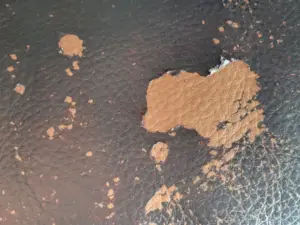Causes of Leather Sofa Sagging and How to Fix it
Leather sofas are a popular choice for many homeowners because of their appearance and durability. However, over time leather sofas can start sagging in the middle, especially if they are not properly cared for.
There are several ways to fix this issue, depending on the severity of the sag.
In this post, we’ll discuss what causes leather sofas to sag and offer tips on how to prevent it. In addition, we will guide you on how to fix your leather couch if it has already started sagging.

What causes leather sofa sagging?
One of the most common causes of leather sofa sagging is poor support especially due to weak or worn-out springs, weak sofa frame, and poor-quality cushions. Without adequate support, the leather stretches due to everyday use resulting in sagging. Other causes include poor quality of leather and normal wear and tear.
1. Weak sofa frame
The frame is the foundation of the sofa because it provides structural support.
When the frame is weak, it can’t support the weight of the upholstered cushions and fabric. Also, the sofa cannot bear the weight of people or objects sitting on it, which results in sagging.
Leather sofas in particular are prone to sagging due to the fact that leather tends to naturally stretch over time.
2. Worn-down or weak sofa springs
Weak or worn-down springs are another element that causes leather couches to sag due to inadequate support.
When a sofa is new, the springs are taut and are able to support the weight of the cushions and users. Over time, though, as the sofa is used more and more, the springs can lose their tension and start to sag. Worn-down springs also make the chair noisy or squeaky.
This is especially likely to happen if the sofa has weak or poor quality springs, which cannot support the weight of people or cushions as well as stronger springs would.
As a result of the sagging of the springs, the cushions will also start to dip inwards and will not be able to provide as much support to the users.
This is often more noticeable in leather sofas because the material is less forgiving and tends to show wear and tear more easily.
3. Poor quality cushions
If you’ve ever sat on a sagging leather sofa, you know how uncomfortable it can be.
Apart from the weak frame and worn-out springs, your sofa can become saggy if it has poor-quality cushions that don’t provide enough support.
For instance, foam cushions might feel too firm on a new leather sofa but they tend to compress over time causing the sofa to sag. Once the cushions start to sag, the leather also follows suit due to stretching. This can ruin the look of your sofa and make it very uncomfortable to sit on.
You can avoid this by choosing high-quality cushions that are filled with materials like down or fiberfill, which don’t lose their shape over time.
4. Normal wear and tear
Another common cause of couch sagging is simply the typical wear and tear.
Over time, repeated sitting and standing can weaken the frame of the sofa and cause the cushions to sag.
Also, the springs may wear down and fail to provide adequate support due to the weight of the people sitting on the sofa. Eventually, this causes the leather and the cushions to lose shape and start to sag.
If you notice that your leather sofa is starting to sag, there are a few things you can do to help alleviate the problem.
First, try fluffing up the cushions and pillows on a regular basis. This will help to redistribute the stuffing and give the sofa a fuller look.
You can also try placing a piece of plywood under the cushions to provide additional support.
How to stop leather sofa sagging
Over time, even the best-made leather sofas will start to sag in the middle. This is especially true if you have a heavy family or tend to use your sofa as a bed on a regular basis.
If your sofa is starting to sag, it’s important to have it fixed as soon as possible. A trained professional can help assess the damage and determine the best way to fix it.
Once you identify the cause of the sagging, here are a few things you can do to prevent or fix it.
-
Flip and fluff the cushions regularly
Flipping and fluffing the cushions regularly is one of the easiest ways to prevent sagging and ensure they last longer.
By doing so, you redistribute the stuffing inside the cushion, which helps to keep it from getting lopsided or lumpy.
Additionally, regular flipping and fluffing will help to keep the leather fabric on the cushions from wearing out too quickly.
-
Use sofa cushion supports
Another option is to place sofa cushion supports that are usually placed under the cushions for extra support.
You can find the sagging sofa support boards online or at any home improvement store.

-
Fix the sagging sofa with plywood
You can also place a piece of plywood to fix your sagging couch. Plywood is a sturdy and durable material that can provide extra support to the cushions and distribute weight more evenly thereby preventing sagging.
To fix a sagging sofa with plywood, you need to identify the sagging areas under the cushions, measure them, cut the plywood to size, and place it underneath the sofa cushions. You can also secure the plywood to the bottom of the sofa frame using screws or nails.
The plywood board will give the couch an extra level of support and make it firm so that it doesn’t sag.
-
Replace the springs
It is possible that the springs in your sofa are worn out, broken, or loose and are causing the sagging.
If the springs are worn out or broken, you may need to replace them altogether in order to restore the structural integrity of the sofa.
You can get replacement springs and have them fixed by a professional or simply DIY.
Alternatively, you could try to stretch the old springs back to their original size if they are not broken. However, if you decide to do this, be very careful because you could damage them even further if you don’t do it properly.
-
Change or refill the cushions
If the cushions are too soft or too old, they will not provide enough support for the couch and will cause it to sag.
So you can prevent leather couch cushions from sagging by changing the filling or adding fiber filling. But if your sagging leather couch has non-removable cushions, you will need to have the refilling done by a professional.
Foam is the most common type of cushion filling, but has a tendency to sag over time.
Fiberfill or down are good alternatives, as they are lightweight and will not lose their shape over time. You can add fiberfill or down feathers to your current cushions or buy new ones that are already filled with them.
Repair a sagging leather couch with non-removable cushions
Repairing a sagging leather couch with non-removable cushions can be a bit challenging but it can be done. The first step is to turn the couch upside down and remove the bottom cover fabric, which is usually stapled in place.
This will allow you to access the internal components of the couch and determine the extent of the damage.
Next, check the frame of the couch for any cracks or warping. If you find any damaged areas, they will need to be repaired or replaced. This may involve adding new pieces of wood or reinforcing the existing frame.
If the webbing that supports the cushions has stretched or snapped, you will need to replace it. This involves removing the old webbing and attaching new webbing to the frame using staples or screws.
Additionally, check the springs that support the cushions underneath. If the springs have warped or bowed, they will need to be boxed in in order to provide more support. To do this, add a wooden frame around the springs to distribute the weight more evenly and prevent further damage.
Furthermore, once you have repaired the frame and springs of the couch, you can add extra filling to the cushions to make them more supportive.
Simply make a small incision in the seam of the cushion and add more filling such as foam or polyester fiberfill as you would with removable cushions.
Alternatively, if you don’t want to make an incision that you will have to stitch after, place the polyfill fiber under the cushions as illustrated in the video below.
Please note that repairing a sagging leather couch with non removable cushions can be a complex process. So if you are not comfortable making changes to the structure of the couch or the cushions, get professional assistance.
Conclusion
Leather sofas may sag due to a weak frame, worn-out or broken springs, poor-quality cushions, or simply due to typical wear and tear.
The best way to fix or prevent this is to choose cushions that are filled with high-quality materials. Down or fiberfill cushions are a good option because they maintain their shape over time.
Also, consider repairing or replacing the springs if broken, add sofa support boards under the cushions, or simply flip and fluff the cushions regularly.
In addition, be sure to choose cushions that are the proper size for your sofa. Too small cushions will cause the leather to bunch up, while too large cushions will make the sofa look sloppy.






